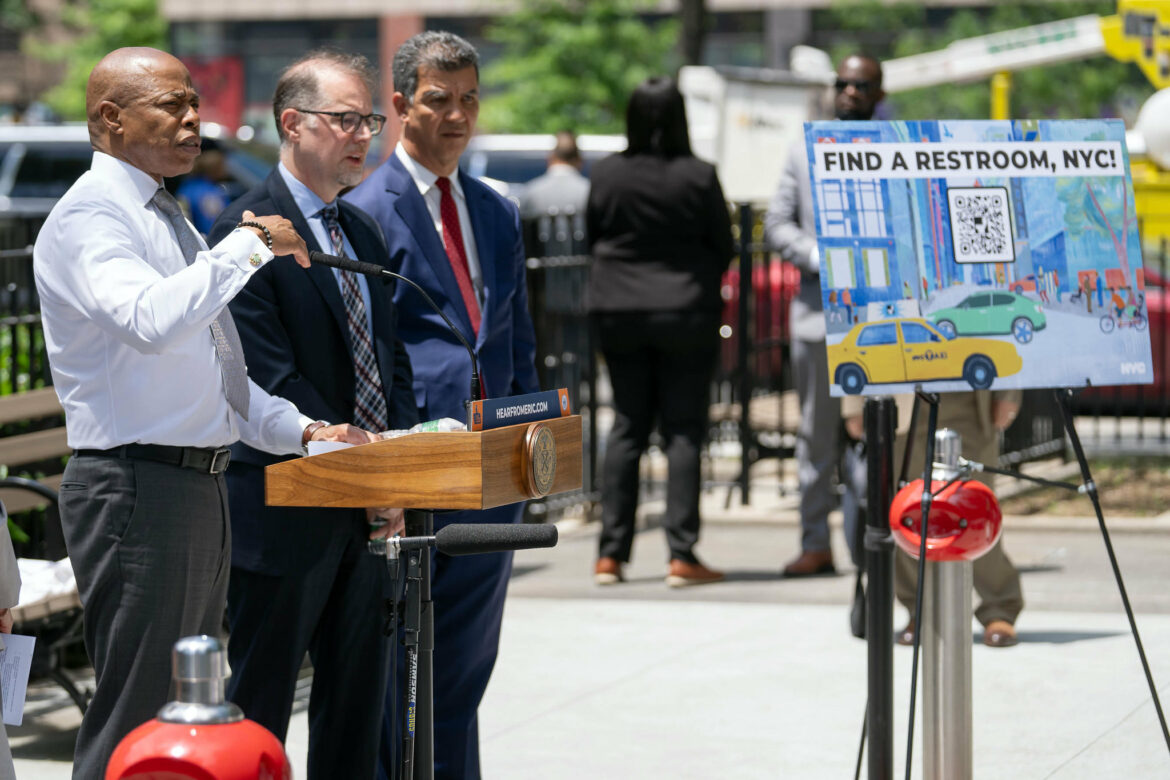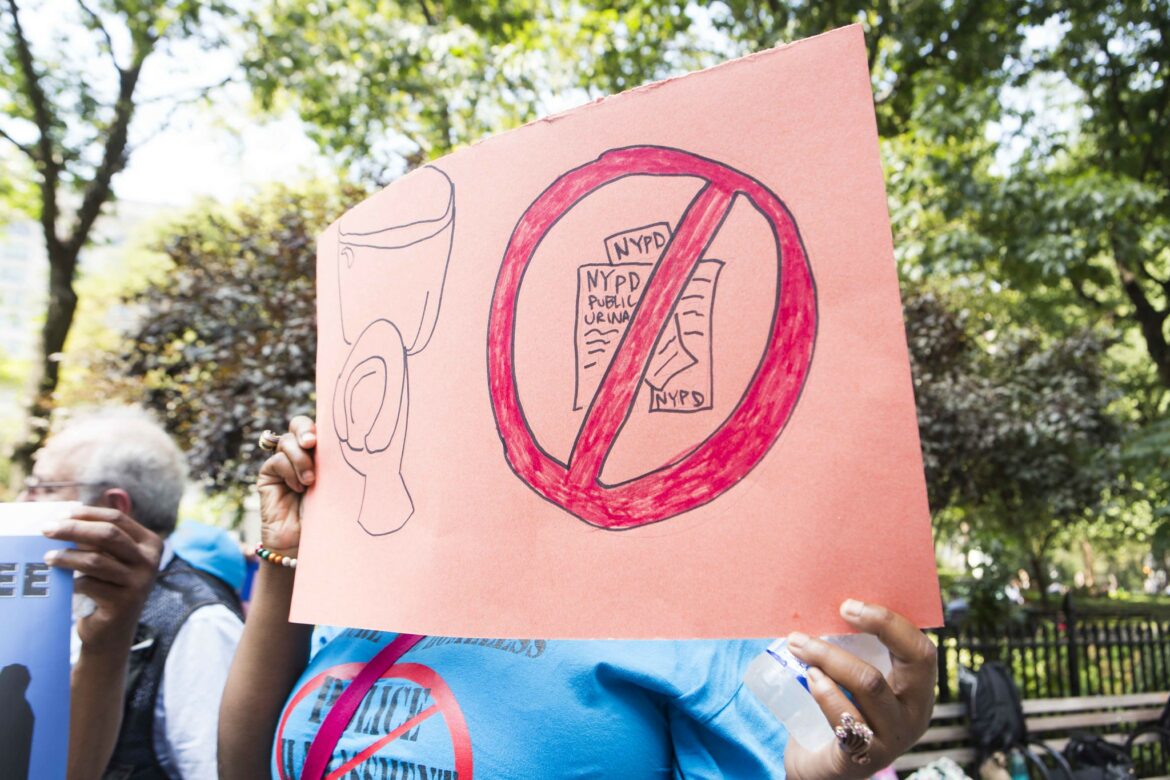While city officials cited the importance of restrooms for all residents of the city, highlighting the needs of young children and older New Yorkers, homeless people also rely heavily on public bathrooms, but face particular difficulty in accessing them, experts and advocates say.

Ed Reed/Mayoral Photography Office.
Mayor Eric Adams launching the new “Ur In Luck,” plan to expand public restrooms on Monday in Manhattan.Mayor Eric Adams’ announcement this week to expand public restrooms across the city is a step in the right direction, but still not enough to meet the need, experts and advocates say.
Under the new Ur in Luck initiative, the city will build 46 new public restrooms and renovate 36 existing ones within the next five years. In addition, the city will site 14 new locations for automatic public toilets within two years. A Google Maps feature is already available for use, where people can use their phones to locate public restrooms operated by various agencies throughout the city.
“If you’re a New Yorker, finding available restrooms is a real challenge, and particularly if you have children, it brings about an additional challenge,” the mayor said during a press conference on Monday.
While city officials cited the importance of restrooms for all residents of the city, highlighting the needs of young children and older New Yorkers, homeless people also rely heavily on public bathrooms, but face particular difficulty in accessing them, experts and advocates say.
For instance, very few restrooms in the entire city are open around the clock. A representative from the Parks Department, which will be managing the new restrooms built under the Ur in Luck initiative, confirmed that the facilities will be open for standard park operating hours, leaving homeless people with few options for relief during late nights or early mornings.
Meanwhile, public library branches—key hubs for both housed and unhoused New Yorkers to access services, escape the elements or use the restroom—are facing reduced hours thanks to budget cuts. The city does operate eight drop-in centers for unsheltered residents, which are open 24 hours a day and offer bathrooms, showers and other resources.
Alison Wilkey, the director of government affairs at Coalition for the Homeless, spoke to City Limits about the need for a more comprehensive restroom plan, one that would include expanded hours of operation, an improved ratio of bathrooms to residents and accessible bathrooms for people with disabilities.
“There are some people who think, ‘Well, if you need a bathroom, you can just go into a restaurant.’ That’s actually not true for everyone,” said Wilkey. “One, a lot of places require that you make a purchase, and two, there are definitely racial differences in how people are perceived when they walk in and ask for a bathroom.”
In 2023, the NYPD issued over 9,300 summonses for urinating in public. Access to toilet facilities is not only a quality of life matter, it’s also a public health concern: people who are unhoused have a 300 percent increased risk of developing a urinary tract infection, due to their limited access to restrooms, according to the “Free to Pee” campaign launched by homelessness advocates to increase bathroom access.

NYC Council/Emil Cohen
A 2018 rally calling for more bathrooms across the city.“It’s great that we are building more bathrooms, but bathrooms take time to build,” Wilkey noted. “The city could take an additional step right now to make more bathrooms available by opening up bathrooms in government buildings.”
Wilkey’s suggestion is proposed in a bill by Councilmember Rita Joseph, which presents a more immediate solution by allowing the public use of restrooms in municipal buildings. Another bill by Councilmember Sandy Nurse addresses the need for a longer term, strategic plan for equitable bathroom access in the city.
In an interview with City Limits, Nurse said the amount of proposed new toilets in the mayor’s plan was a “sad number.” It misses the mark for the adequate number of bathrooms for public spaces used by other large U.S. cities, according to research compiled by the Urban Design Forum. While New York currently has about one bathroom per 7,700 residents, Nurse’s bill aims to increase the ratio to one for every 2,000 residents by the year 2035.
“As one of the biggest municipalities in the world, we should be able to make more than 82 bathrooms in five years,” Nurse said. “That’s an embarrassing rate of construction, especially when there are more flexible options that I think would allow the city to hit a larger goal faster.”
One unique bathroom option recently introduced in Nurse’s district, at Bushwick’s Irving Square Park, is the Portland Loo, the first of its kind in Brooklyn. Named after its city of origin, The Portland Loo is a compact structure that boasts cost efficiency, easy cleaning and 24/7 accessibility.
Housing advocates at VOCAL-NY raised another solution policymakers could consider: opening more bathrooms within the subway system. Out of 472 MTA subway stations, 133 restrooms were operational prior to the COVID-19 pandemic. Some 58 are currently open, albeit from 7 a.m. to 7 p.m., according to published reports.
Althea Matthews, 65, is a leader in the Homelessness Union of VOCAL-NY and previously worked on its “Free to Pee” campaign.
“There’s a lot of homeless people on the subway that need to be able to use the bathroom,” Matthews said. “When they are unable to, they get a ticket because they have to release themselves.”
Matthews has been involved in housing rights activism since 2015. She experienced three years of homelessness in 2019 before moving into her home in January 2023. She stressed the importance of accessible bathrooms for the homeless, as a way to both prevent health complications and avoid criminal charges and fines for public urination.
“This issue is vital to ensure that we’re reducing interactions people have with our criminal justice system,” said Adolfo Abreu, the director of housing campaigns at VOCAL-NY. “It also gets us to think more dynamically about what services and care homeless New Yorkers require.”
To reach the reporter behind this story, contact Anastasia@citylimits.flywheelstaging.com. To reach the editor, contact Jeanmarie@citylimits.flywheelstaging.com
Want to republish this story? Find City Limits’ reprint policy here.









2 thoughts on “NYC Plans to Expand Public Restrooms. Will it Benefit Homeless New Yorkers?”
NYC obviously needs hundreds of public bathrooms. But considering the atrocious states of two public bathrooms I recently visited — in Riverside Park in the 60s by the pier/cafe and in Hunters Point Park in LIC —just having them available is not the answer: they must be continuously maintained. If one has to pay 50 cents or a dollar to use a public restroom to pay for a worker there to keep it clean, that not only guarantees clean toilets, it gives a lesser-educated person employment, municipal employment. If someone is too poor to pay, exceptions can be made. This is done throughout the world and there is no valid reason it can’t be done here.
The lack of facilities is a disgrace. Image, not only homeless New Yorkers, but visitors from the USA and rest of World needing to go. They shouldn’t need insider knowledge or have to make a purchase to take a leak, their visit is already costing them plenty.
Councilmember Nurse is exactly right. Dozens of new restrooms several years from now is not good enough. There’s no excuse for NYC not spending a fraction of what it devotes to PD overtime for parades (for example) addressing this basic human need.
When there’s a big concert in Central Park, organizers seem to have no trouble deploying dozens of temporary restroom stalls. Evidently, NYC can contract out anything and everything, but can’t pick up a phone this afternoon and order several hundred of these porta-potties including maintenance.
Instead of high tech nonsense like tapping a mobile payment device instead of swiping a perfectly good MetroCard, or replacing regular subway ads with video screens, how about spending public revenues on something that actually benefits the public: such as a place to pee *now* not in 5 years.